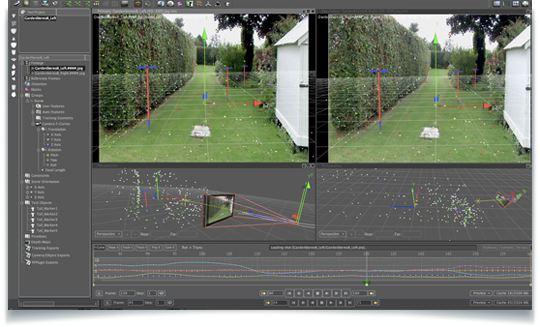The Pixel Farm recently announced PFTrack 2011 during NAB. PFTrack, the company’s flagship 3D camera tracking and matchmaking application has been completely re-written to be 64-bit, GPU accelerated while still using trademark node-based architecture. Check out the info for PFTrack 2011 here.
New features in PFTrack 2011 include
Node-based Flowgraph Architecture
The Tracking Tree controls the flow of data as nodes are connected to perform all of the various tasks in PFTrack 2011 such as image processing, feature and geometry-based tracking, camera solving, image modelling and file export. Nodes may be infinitely branched allowing multiple techniques to be used to achieve the most accurate result.
Geometry Tracking
Geometry Tracking can be used to track either the camera or a moving object, using a triangular mesh instead of tracking points, which avoids many of the typical pitfalls that plague conventional tracking such as glints, highlights and motion blur. In PFTrack 2011, Geometry Tracking has been enhanced so that it may be used to track a deformable object like a talking face. This can be achieved by creating one or more deformable tracking groups, assigning some of the triangles in the mesh to those groups, and specifying how the groups can transform relative to the rest of the mesh.
Image Modelling
Image Modelling can be used to construct 3D polygonal models that match elements viewed by a tracked camera. A set of modelling primitives are provided that can be positioned in 3D space and edited to match the image data, or new models can be constructed by connecting 3D vertex positions to form a polygon mesh. Z-Depth can be used to estimate the distance of every pixel in an image from the camera frame, producing a grey-scale depth map image encoding z-depth, and a triangular mesh in 3D space. Texture UV maps can be created and edited for any object, and both static and animated textures can be mapped onto geometry for export.
Stereoscopic Tracking
When tracking a stereoscopic camera in PFTrack 2011, auto and user features are tracked simultaneously on both the left and right eye images. When solving the camera, artists have full access to the data defining the rig including interocular distance, convergence, etc.
Image Processing
Already benefiting from the Enhance, Shutter Fix and rotoscoping capabilities of PFMatchit, PFTrack 2011 adds a new Optical Flow tools to calculate dense optical flow fields describing the apparent motion of objects relative in the camera plane. It will also retime clip and motion data to increase or decrease the apparent frame-rate of the camera.
Mocap Solver
The Mocap Solver node can be used to calibrate the motion of individual tracking points viewed from two or more camera positions. This is often used to track the motion of an actor’s body or face, where tracking points have been identified using physical markers. In contrast to standard object tracking, the Mocap Solver node does not assume that the object is moving in a rigid fashion. The motion if each tracking point is completely independent and can therefore represent movement of non-rigid objects.
Already the industry-leading 3D camera tracking and matchmoving application, PFTrack 2011 introduces innovative solutions to the diverse challenges of advanced matchmoving faced by independent artists, and large visual effects teams working within complex creative pipelines. From extensive plate preparation tools and renowned lens distortion management, through single-camera and stereoscopic 3D camera tracking, image-based modelling and scene reconstruction, PFTrack 2011 sets a new benchmark as the most complete toolset available, with unprecedented levels of power, precision, flexibility and control over every aspect of the matchmoving process.
“PFTrack 2011 has been completely re-written as a 64-bit, GPU-accelerated application, allowing scalable performance as more robust components becomes available, while vastly improving processing speeds on modest computer hardware. Significant increases in productivity are accomplished through The Pixel Farm’s distinctive node-based flowgraph architecture. The Tracking Tree allows artists to experiment with multiple techniques in a non-linear, non-destructive environment to achieve the most accurate solution possible. Newly designed Image Modelling tools, with full-resolution Texture Extraction, generate detailed geometry for scene fitting, shadow boxing, and set reconstruction. PFTrack’s per-pixel Z-Depth now supports masks to specify the relative depth ordering of objects in the scene, producing a grey-scale depth map image and triangular mesh geometry. Geometry Tracking now supports deformable groups, allowing a triangular mesh to deform as it’s vertices track a non-rigid moving object, such as an actor’s face while speaking. Extensive image processing capabilities include Shutter Fix for correcting the rolling shutter errors of footage originating from CMOS sensor cameras, Transform Clip for cropping, resizing and rotating source footage, a new Optical Flow node for calculating and exporting dense motion fields, vector-based keyframable Retiming, unsurpassed Lens management, and a host of Enhancement functions for making footage more “trackable”.”

